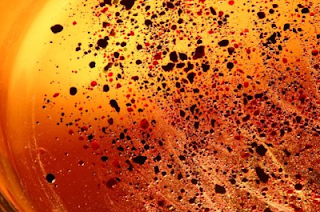After doing some basic oil and water experiments, I wanted to look for some inspiration as to how I could develop my ideas.
 |
| I tried using food colouring to colour the water, but the food colouring didn't add to the effect as the oil also changed to that colour. |
 |
| I tried swirling the oil to separate the oil into different bubbles, but I found they all joined into one bubble. |
I found an artist called Sharon Johnstone, a fine artist who enjoys macrophotography in which she also explores the relationship between oil and water. Her website gave me some tips as to how she creates her work, for example, putting a picture under the glass rather than food colouring, to add some texture to the end photo, and also using washing up liquid to help the oil bubbles stay separate.





























